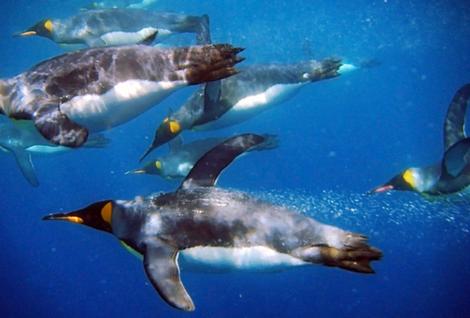It is well known that the penguin is a very unique type of bird that lacks the ability to fly. Many scientists believe that they are descendents of very early types of birds, and that they were forced to adapt to living in the water in order to survive. Thus, their “wings” that were once feathered for them to fly are now flippers that allow them to swim and glide underwater.

Many times penguins are photographed on shore in their colonies. However, they actually spend about ¾ of their time in the water. In fact, depending on where they live, they may spend weeks or even months at a time in the water before returning to land. This is true especially in Polar Regions in which the penguins are surrounded by ice.
So how are these creatures able to spend so much time in the water?
They do so by using their penguin wings, which are called flippers. These are hard, rigid paddles that are covered with tiny stiff feathers. The penguin’s flippers are shaped much like the wing of an airplane. This is very interesting considering the fact that the flippers are not used for flight, but for simply guiding and maneuvering in the water. Since penguins have solid, heavy bones, they are less buoyant and can gain speed underwater on the up and down strokes of their flippers. This is different from normal birds whose hollow bones and wing shapes only allow increased speed on the down strokes.

Penguins use their flippers to dive a great distance into the water to obtain their food. Depending on the species, it may be up to 1,700 feet! However, it is necessary that they surface for air on a regular basis. The period of time that they can remain under the water without doing so is from two minutes to twenty minutes depending on the species. Thus, they must use their flippers to quickly navigate the waters at amazing speeds.
Sources:
2 Comments
Lorena Barba posted on October 11, 2011 at 4:08 pm
Hi Nathan,
It sounds like the penguin is a bird that has lost the ability to fly,right? Their ancestors did fly?
It’s a very nice post, but I am confused about two things. The first, is the idea that their heavier bones make them more buoyant. I see that your reference used the word “buoyancy”, but it doesn’t sound correct. Buoyancy is the force due to the displaced water, so it depends on the volume and not the weight of the penguin! The second question I have is … do they really dive to a depth of 1700 feet? That sounds like a whole lot, more than 500 meters!
Nathan Provencher posted on October 12, 2011 at 1:27 pm
Yes, it does seem that is quite possible that the penguin was once a flying bird, but lost this ability over time.
For the buoyancy part, I realize now I made a mistake in typing “more” rather than “less” so I have made this correction in the post. As for the question regarding their ability to dive to such incredible depths: this is in fact true for some species of penguin. While the smallest type of penguin called the Blue Penguin can only manage 60 meters at most with a two minute breath, the Emperor penguin is able to dive for up to 20 minutes to about 550 meters! It is an amazing concept and understandably hard to grasp, but it is true!